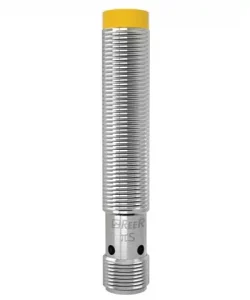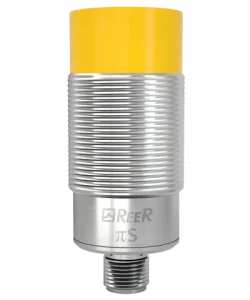REER Inductive Proximity Sensors
What are inductive proximity sensors?
Inductive proximity sensors are non-contact devices that detect the presence of metallic objects using electromagnetic fields. REER inductive proximity sensors are built for precision, robustness, and safety compliance, making them ideal for demanding industrial environments.
How do inductive proximity sensors work?
These sensors generate an oscillating electromagnetic field from a coil. When a metal object enters this field, it alters the oscillation, which triggers the sensor output. REER sensors, such as the PI M12 NF or PI M30 NF, are designed for high switching accuracy and safe operation in industrial automation systems.
Key Advantages of Inductive Proximity Sensors
Non-Contact Sensor Functionality
REER inductive proximity sensors are non-contact devices, meaning they operate without any physical interaction with the target object. This minimizes mechanical wear, extends the service life of machinery, and reduces the need for frequent maintenance. Non-contact sensing is ideal for applications where hygiene, precision, and durability are essential.
Protection Rating
REER sensors are engineered with robust protection ratings, including IP67 and IP69K, to withstand harsh industrial conditions. These ratings ensure reliable performance in environments with high moisture, dust, or direct washdowns, making them suitable for food processing, pharmaceuticals, and outdoor applications.
Target Object Detection
Inductive sensors from REER are specifically designed to detect metallic target objects with high repeatability. Whether it’s stainless steel, aluminum, or mild steel, these sensors provide stable detection performance regardless of shape or finish. Proper alignment and sensing distance help optimize the accuracy of target detection.
Environmental Conditions Compatibility
Built for demanding environments, REER proximity sensors are resistant to temperature fluctuations, vibration, humidity, and corrosive agents. Their rugged housings and sealed electronics ensure consistent performance even in extreme industrial settings, from freezing warehouses to high-heat foundries.
Machine Safety Integration
REER inductive proximity sensors contribute to machine safety by offering fail-safe operation with OSSD outputs and EN 60947-5-3 compliance. These features make them suitable for use in safety interlocks, emergency stop circuits, and presence detection zones around dangerous machinery. Their fast response time and diagnostic feedback support reliable risk mitigation.
Switching Distances
REER inductive proximity sensors are available in various sizes—M12, M18, M30, and square-body formats—with switching distances ranging from 2 mm to 20 mm, depending on the model and mounting type (flush or non-flush). The extended switching range allows for greater design flexibility and precise positioning in tight spaces. These optimized distances help reduce false triggers and improve detection reliability in safety-critical applications.
Sensing Distance
Sensing distance refers to the maximum range at which a sensor can reliably detect a metallic object. REER sensors feature both standard and extended sensing distances, making them suitable for compact spaces as well as long-range detection tasks. Choosing the appropriate sensing distance is essential for applications like part presence verification, object positioning, and safe zone monitoring in automated machinery. REER inductive proximity sensors are available in various sizes—M12, M18, M30, and square-body formats—with switching distances ranging from 2 mm to 20 mm, depending on the model and mounting type (flush or non-flush). The extended switching range allows for greater design flexibility and precise positioning in tight spaces. These optimized distances help reduce false triggers and improve detection reliability in safety-critical applications.
Switching Frequency
REER sensors offer fast switching frequencies—up to 2 kHz in select models—enabling high-speed detection in dynamic industrial environments. This high frequency ensures responsive performance in applications involving fast-moving metal parts, conveyor belts, or robotic arms. Choosing the right switching frequency is critical for synchronizing sensor output with system timing in automated workflows. REER inductive proximity sensors are available in various sizes—M12, M18, M30, and square-body formats—with switching distances ranging from 2 mm to 20 mm, depending on the model and mounting type (flush or non-flush). The extended switching range allows for greater design flexibility and precise positioning in tight spaces. These optimized distances help reduce false triggers and improve detection reliability in safety-critical applications.
Reliability and precision
With OSSD outputs and EN 60947-5-3 certification, REER proximity sensors offer fail-safe operation. Their high switching distance and repeatability make them suitable for safety-critical applications.
Non-contact operation benefits
As non-contact sensors, they reduce wear and tear, increase system uptime, and eliminate the need for mechanical actuators. This improves both performance and maintenance cycles.
Longevity and maintenance
Thanks to their IP69K-rated housing and durable design, REER inductive sensors excel in harsh environments. They require minimal maintenance, saving costs over time.
Types of Proximity Sensors
Sensor Type
REER offers a wide variety of inductive sensor types to suit different industrial applications:
- Cylindrical sensors (M12, M18, M30): These threaded body sensors are easy to mount and available in both flush and non-flush configurations.
- Square and rectangular sensors: Compact models ideal for tight spaces or surface mounting without the need for brackets.
- Safety-rated sensors (PI-Safe series): Certified to EN 60947-5-3, designed for use in functional safety applications with OSSD outputs.
- IO-Link sensors: Smart connectivity for real-time diagnostics and integration with Industry 4.0 systems. Each sensor type supports different mounting, sensing distance, and output needs, providing tailored solutions for a broad spectrum of automation tasks.
Output Type
REER inductive proximity sensors are available with various output configurations to support integration with different control systems:
- PNP and NPN outputs: Compatible with sourcing or sinking logic inputs in PLCs.
- Normally open (NO) and normally closed (NC): Available depending on switching requirements.
- OSSD (Output Signal Switching Device): Found in safety-rated models for redundancy and diagnostics in safety circuits.
- Analog outputs: Optional for advanced detection scenarios requiring distance-based feedback. Choosing the correct output type ensures seamless compatibility and optimal performance within the control architecture. REER offers a wide variety of inductive sensor types to suit different industrial applications:
- Cylindrical sensors (M12, M18, M30): These threaded body sensors are easy to mount and available in both flush and non-flush configurations.
- Square and rectangular sensors: Compact models ideal for tight spaces or surface mounting without the need for brackets.
- Safety-rated sensors (PI-Safe series): Certified to EN 60947-5-3, designed for use in functional safety applications with OSSD outputs.
- IO-Link sensors: Smart connectivity for real-time diagnostics and integration with Industry 4.0 systems. Each sensor type supports different mounting, sensing distance, and output needs, providing tailored solutions for a broad spectrum of automation tasks.
Inductive vs. capacitive sensors
While inductive sensors detect only metal objects, capacitive proximity sensors can sense both metallic and non-metallic targets like plastic and liquid. For metal detection applications, inductive models like REER PI-Safe are more suitable.
Magnetic and photoelectric sensor comparison
Photoelectric sensors work over longer ranges but are sensitive to light and dust. Magnetic sensors are ideal for extreme environments. REER’s inductive sensors outperform in environments requiring metal detection with high precision.
Extreme temperature sensors
REER sensors with ruggedized housings and temperature-resistant components are suitable for extreme temperature zones in industrial ovens, furnaces, or cold storage.
Industrial Applications
Role in manufacturing processes
From assembly lines to packaging systems, REER proximity sensors enhance safety and automation. They detect object presence, position, or movement, enabling precise control.
Use in safety systems
These sensors are compatible with safety PLCs and meet stringent safety standards, ensuring reliable integration into emergency stop circuits or hazard zone detection.
Integration with Automated Guided Vehicles (AGVs)
REER sensors can be installed on AGVs for collision avoidance and alignment verification in logistics and material handling environments.
Scissor lifts and other machinery
Inductive proximity sensors are widely used in access equipment like scissor lifts to confirm position locking, door closure, and stabilizer deployment.
Additional Applications Across Industries
REER inductive proximity sensors are also utilized in:
- Food and beverage production: Detecting metal containers, checking fill levels, and monitoring conveyor belt operations.
- Automotive industry: Assisting in robotic assembly lines and paint shop automation.
- Pharmaceutical manufacturing: Ensuring contamination-free object detection in sterile environments.
- Packaging and labeling: Triggering print-and-apply label machines and verifying item presence.
- Metalworking and machining: Monitoring the position of moving parts and ensuring operational safety in CNC machines.
Innovations in Inductive Proximity Sensing
IO-Link connectivity features
REER offers IO-Link-enabled models, allowing real-time diagnostics, device identification, and remote parameter configuration in Industry 4.0 systems.
ATEX-certified sensors
For explosive environments, ATEX-certified REER sensors provide safe operation in oil & gas, chemical, and food processing industries.
Case studies: Leading companies and solutions
Global OEMs rely on REER PI M18 NF and PI SQ NF sensors for metal object detection in conveyor lines, robot arms, and safety interlocks.
Future Trends in Proximity Sensing Technology
Emerging technologies and enhancements
Next-generation sensors will feature hybrid detection (inductive + photoelectric), increased switching frequencies, and higher temperature resilience.
The impact of Industry 4.0
As smart factories evolve, REER sensors with IO-Link and predictive maintenance capabilities will help reduce downtime and enhance throughput.
Sustainability and efficiency advancements
Efficient circuitry, recyclable materials, and low-energy operation are shaping the next wave of REER inductive proximity sensors designed for a sustainable future.

